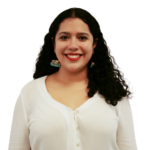Once upon a time, a little girl discovered the joy of reading through gossip magazines, tales of world and national celebrities, and stories about royalty (mainly British). The little girl’s first lessons were not about the history of her country but about Queen Elizabeth, her reign, hairstyles, travels, children, scandals, sports, clothes, fashions, and brands such as Gucci, Dior, or Chanel. As she read, doubts arose; for some, she got answers with the help of an adult; for others, she found answers in an encyclopedia or Encarta (which was born in the 90s); and for some, there was no answer. However, that didn’t matter to her because she loved to read! Over time, through television, she broadened her vision of the world. She realized that it was bigger than she thought. She watched many English programs she did not understand well, and her love for reading continued. Then she found a new best friend: the English-Spanish dictionary.
“[My book-friends]. They talk to me without embarrassment or awkwardness.”
– Helen Keller
Reading refers not only to books but also to a wide range of textual carriers. Consequently, we must understand any interaction between a text and a reader that results in meaning. Readers are not homogenous but a varied group comprising individuals who use written language to store, communicate, transmit information, or enjoy aesthetic sensations. Reading is fruitful because it increases and improves imagination, critical thinking, and language, provides information and knowledge and promotes freedom, among many other benefits.
For Andruetto (2014), reading is an interventional instrument for the world that allows us to think, take a step back, and reflect; it offers the potential for questions, discussion, the exchange of perceptions, and the forming of individual judgment (pp. 111-112). Likewise, for Garrido (2014), reading plays a vital role in academic, professional, and personal life. For this reason, reading shouldn’t be only a school activity but an immersion in every moment of daily life.
Mexico rises to the call for reading!
In 2022, Mexico was assessed as deficient in reading skills developed by young people, exposing the Mexican educational system to widespread criticism. The OECD’s Program for International Assessment (PISA) test measures the performance of 15-year-old students about to complete compulsory education and the essential knowledge and skills they need in reading, mathematics, and science to enable them to function fully in society. The results presented for 2022 show that Mexico scored 415 in reading, 410 in science, and 395 in mathematics; all three areas, unfortunately, are below expected levels. Singapore is the leading country in all three topics, attaining 543 points in reading, 575 in math, and 561 in science.
In Mexico, efforts to promote reading focus on two main aspects: developing literacy levels and providing books to all. The political discourse of the National Education System attaches great importance to the development of reading and the training of writers and autonomous readers by introducing bibliographic material into each elementary education classroom. However, these strategies must be efficiently integrated to avoid nullifying efforts to create campus libraries or collections.
“He who does not fall slides.”
We have seen examples of politicians or entertainment figures who, when asked about their Top Three favorite books, struggle to think and respond in a rushed or generic way. It’s possible that the situation makes them nervous or that reading is not part of their day-to-day activities. Without judging, we must ask ourselves if we are reading or creating spaces to cultivate our imagination. According to 2022 INEGI statistics, Mexicans read an average of three books yearly. It also reports that 71.8% of the literate population aged 18 and over read some of the materials on the MOLEC reading module training instrument: books, magazines, newspapers, comics, Internet pages, forums, or blogs. On the other hand, social networks also impact our reading habits as we consume physical and digital books and magazines. After the pandemic, the use of platforms to access books and make purchases online increased, which reflects the impact of the internet and social networks on the daily lives of the Mexican population.
The causes of low reading rates may be inherent to social, educational, or psychological factors. In Mexico, significant differences in the sociocultural conditions of individuals result in an understandable hierarchy of reading behaviors. Another reflection calls to mind the types of social rewards obtained through reading. The difference between the illiterate and the literate is evident because the former are generally in the lowest social classes, do not have access to some information, and find it difficult to coexist in a literate society. However, the situation for people who can read and write could be more precise because there is a great diversity in the levels of reading competency and the types of reading they do for specific purposes.
Cultivating a love of reading in the classroom
Acquiring the habit of reading is not easy at any age, but we can do small things to achieve it in the classroom. In the Ethical Concepts and Dilemmas course I teach at Universidad Tecmilenio, I had the opportunity to explore different readings with my high school students throughout the school cycle. Through the Love for Reading Calendar, we confronted monthly challenges with various topics and authors aligned with the students’ tastes and stages of life. (See the example in Image 1.)

The image shows a “Reading Challenge Calendar.” It should be based on the tastes of each class. The teachers can suggest topics and books they already know and ask the students’ opinions to get to know them better. Here are some tips for integrating the reading calendar into class:
- “In exchange for what?”: Compensate the students for reading books; i.e., give prizes for each reading achievement. These can be extra grade points or more time to answer exam questions.
- “Hoarse-voiced”: Read aloud for 15 minutes per day in class so students become accustomed to seeing reading happen regularly.
- “Book or movie?”: Show some movies based on books for students to contrast and question the versions in the book and film; they can become curious to read so they can argue their theories.
- “Goodbye, cowboy”: If a reading is not to the reader’s liking, allow them to dislike it. We should not all think the same way. Students who feel that their individuality is validated will feel calm.
- “Come, friend, I invite you to a book.” Surrounding ourselves with people who like to read helps us share the habit of reading and fill ourselves with knowledge.
It is essential to encourage students to enjoy reading by creating class spaces where they can comment on what they have read and learned. This activity will enrich their vocabulary, knowledge, and perspective, help them express themselves, and improve their performance when speaking in front of their peers and the public.
Reflection
Remember that we cannot demand what we do not give; if we want children and young people to read and understand what they are reading, we must also have the excellent habit of reading. Reading impacts our lives meaningfully, allowing us to know new places, experiences, and situations. Please encourage reading as an excellent training tool for life. It’s not about banning social media, mobile devices, video games, or television. It is about adding to all this the love for reading and its enriching experience.
Reading is a tool that allows us to feel, perceive, understand, and face the vicissitudes of life with greater clarity, information, and knowledge. However, many people prefer not to read, so it is essential to reflect on reading practices and the difficulties or barriers that erect adversity toward reading.
Update: The girl in the first paragraph has grown up and continues to love books, magazines, and podcasts. Her imagination and creativity grow daily, and each reading stays in her heart.
About the Author
Yadira Díaz (lic.yadiradiaz@gmail.com) holds a law degree from the University of Sonora and a master’s in Education from Tecmilenio University. She has taught high school and college. She is confident that “the world is a place where we can all improve and that every day is an opportunity to believe in ourselves.”
References
Del Ángel, M., Rodríguez, A. (2007). La promoción de la lectura en México. Redalyc. 011 https://www.redalyc.org/pdf/277/27701101.pdf
Muro Ramírez, D. (2015). Motivos de falta de hábito de lectura académica, en universitarios de Mexicali. Revista Electrónica de Psicología Iztacala. 18 (2) 2015 https://www.iztacala.unam.mx/carreras/psicologia/psiclin/vol18num2/Vol18No2Art13.pdf
Ruiz Gómez, Janett, & Mireles Cárdenas, Celia. (2023). Prácticas de lectura de los jóvenes de la Facultad de Ciencias de la Información de la Universidad Autónoma de San Luis Potosí, México, 2022. E-Ciencias de la Información, 13 (1), 71-87. https://dx.doi.org/10.15517/eci.v13i1.52543
Peredo Merlo, María Alicia. (2005). ¿Es verdad que México busca formar lectores? Espiral (Guadalajara), 11(33), 167-188. Recuperado en 09 de enero de 2024, http://www.scielo.org.mx/scielo.php?script=sci_arttext&pid=S1665-05652005000200006&lng=es&tlng=es.
De, Más, De pesos, 000 Millones, Fondos, de D., & De todos los mexicanos, P. P. L. L. al A. (s/f). Las bibliotecas públicas se integrarán en una verdadera red de información, conocimiento y lectura: Vicente Fox Quesada. Gob.mx. Recuperado el 1 de abril de 2024, de https://dgb.cultura.gob.mx/bibliotecario/pdf/ElBibliotecario12.pdf
How did countries perform in PISA? (s/f). Oecd-ilibrary.org. Recuperado el 4 de abril de 2024, de https://www.oecd-ilibrary.org/sites/9149c2f5-en/index.html?itemId=/content/component/9149c2f5-en
(S/f). Gob.mx. Recuperado el 4 de abril de 2024, de de Educación Pública, S. (s/f-a). Conoce el Sistema Educativo Nacional. gob.mx. Recuperado el 5 de abril de 2024, de https://www.gob.mx/sep/articulos/conoce-el-sistema-educativo-nacionalhttps://www.sep.gob.mx/work/models/sep1/Resource/1447/1/images/sistemaedumex09_01.pdf
Kemp, S. (2024, febrero 23). Digital 2024: México. DataReportal – Global Digital Insights. https://datareportal.com/reports/digital-2024-mexico
(S/f-b). Org.mx. Recuperado el 5 de abril de 2024, de https://www.inegi.org.mx/contenidos/saladeprensa/boletines/2022/EstSociodemo/MOLEC_2022.pdf
Average books read per year by country 2024. (s/f). Worldpopulationreview.com. Recuperado el 5 de abril de 2024, de https://worldpopulationreview.com/country-rankings/average-books-read-per-year-by-country
La Lectura, E. P. (s/f). La lectura, otra revolución. Com.ar. Recuperado el 5 de abril de 2024, de https://fce.com.ar/wp-content/uploads/2020/11/AndruettoLLOR.pdf
(S/f-c). Com.mx. Recuperado el 5 de abril de 2024, de https://www.eleconomista.com.mx/arteseideas/La-lectura-una-manera-de-aprender-pensar-y-crecer-Felipe-Garrido-20180217-0026.html PISA 2022 results (volume I): The state of learning and equity in education. (s/f). Oecd-ilibrary.org. Recuperado el 18 de abril de 2024, de https://www.oecd-ilibrary.org/sites/53f23881-en/index.html?itemId=/content/publication/53f23881-en
Editing
Edited by Rubí Román (rubi.roman@tec.mx) – Editor of the Edu bits articles and producer of The Observatory webinars- “Learning that inspires” – Observatory of the Institute for the Future of Education at Tec de Monterrey.
Translation
Daniel Wetta
This article from Observatory of the Institute for the Future of Education may be shared under the terms of the license CC BY-NC-SA 4.0 
)
)


)